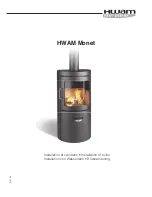
34000 Autry Street, Livonia, MI 48150 | 800.968.5530 | Fax 734.419.0209 | www.hamiltonengineering.com | LIT91127US REV 5/2018
Page 17
E. SETTING THE MAXIMUM LOAD
A means of sampling the leaving flue gas is built into the vent connector on top of the appliance. Remove the
rubber plug for testing and replace when testing is completed. This plug MUST be in place during normal operation.
• Press the service button with a pointed object and set the temperature knob on the maximum fan speed as
shown by model in the table below
(RPM = display * 100, ex. 060 = 5951–6050).
(TABLE 3-5) FAN SPEED REQUIREMENTS
Natural Gas CO
2
Natural Gas CO ppm
LP Gas CO
2
LP Gas CO ppm
Cover On
Cover Off
Approximate, do not use for setup!
Cover On Cover Off
Approximate, do not use for setup!
LOW FIRE
8.5%
8.3%
Less than 10
9.6% 9.4%
Less than 15
HIGH FIRE
8.8%
8.6%
Less than 110
10.0% 9.8%
Less than 120
Last 4 digits of serial number
HWD 79, HWH 79, HWH 79.8
First Week
Last Week
Maximum rpm
Minimum rpm
02--08
current
6400
1856
Please note: All adjustments must be made with the appliance door off, which will lower the CO
2
reading
0.2%.
See tables above for specific readings.
When checking or replacing a gas valve, the CO
2
percentage in the flue gas is the preferred measuring method
to insure proper combustion and firing rate. CO is used as the (temporary) alternate.
Changing incoming air temperature may vary the CO
2
setting slightly (~0.2–0.6%) after initial set up. This is not
cause for concern or reason to set up again. After one year of operation, set up is required again.
If your appliance will be operated in an area that has inlet air temperature variations greater than 80ºF, please
use the following table in adjusting your CO
2
for optimum performance.
Inlet air ∆T variation
Setup at minimum incoming
air temperature
Setup at maximum incoming
air temperature
80ºF
Reduce CO
2
0.2%
Increase CO
2
0.2%
100ºF
Reduce CO
2
0.3%
Increase CO
2
0.3%
120ºF
Reduce CO
2
0.4%
Increase CO
2
0.4%
If necessary, turn the adjusting slot [1], which sets the high fire performance, either counterclockwise to increase
the CO
2
percentage or clockwise to reduce the CO
2
percentage, as shown in Figures 3-2 and 3-3, page 15.
Appropriate CO
2
percentages are shown in Table 3-3 above.
GAS CONNECTION
(TABLE 3-4) CO
2
ADJUSTMENT TABLE
(TABLE 3-3) COMBUSTION & FUEL RELATED ADJUSTMENT TABLE
















































